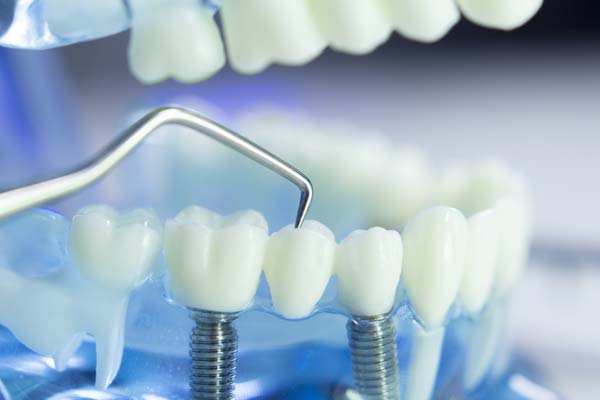The 3 Parts of Dental Implant Tooth Replacement

A dental implant can replace a deteriorated natural tooth. Your dentist will try everything to keep the tooth intact. Replacing the tooth is important if the tooth is too damaged. Removable dentures will not provide the stability or strength you need. An implant will be the ideal tooth replacement. If you want to know the three vital parts of a dental implant procedure, here are the details.
The post
This is the fixture or titanium rod the dentist places in the jawbone. The dentist will cut through the gum tissue first. This will expose the jawbone. Drilling dental implant holes into the jawbone will be next.
These titanium posts serve as dental roots. They stimulate the jawbone. This signals the body to send nutrients to the jawbone for tissue repair and cell growth. It prevents jawbone loss.
Titanium is the ideal material because of its biocompatibility. This means the body will not reject it. This metal has a hydroxyapatite coating as well. This coating helps the post fuse with the jawbone.
Dental implant posts vary in size. The dentist chooses the right size based on the tooth in need of replacement. The dentist will choose a mini or narrow dental post to replace an incisor. A titanium rod with a larger diameter will replace a molar.
Zygomatic implant posts may apply in some cases. These are longer fixtures capable of reaching the zygomatic bone and jawbones. The dentist uses them when there is a lack of proper jawbone mass. A good amount of bone mass is necessary for good osseointegration. This process is the fusion of the titanium rods with the jawbone. It often takes four to six months to finish.
Successful osseointegration can lead to the success of dental implant surgery. This will help the titanium rods stay in place. The stability it will provide can help the individual chew, bite, talk, and smile without any issue. It will also allow the replacement to look natural.
The abutment
This is the connector between the titanium rod and the dental crown. The dentist will need to cut through the gum tissue on top of the titanium rod. Attaching the abutment will come next. There are also different types of abutments. The choice depends on the type of dental prosthetic in need of support.
Some abutments can go from different angles. This ensures the natural appearance of the artificial dentition. In some cases, abutments go with the post before osseointegration. Other abutments need to wait for the osseointegration to finish first.
The dental prosthetic
This is the exposed part of the dental implant. It can be a denture, dental crown, or dental bridge. Dentures replace the entire dental arch. These artificial teeth snap onto the abutments. Dental crowns can replace at least one missing tooth far from each other. Dental bridges can replace at least two consecutive missing teeth.
Caring for dental implants
These dental restorations will need extra care because these are artificial replacements. Like natural teeth, the implants are prone to damage. Using a soft-bristled toothbrush can help clean the teeth without abrading them. The gums also remain scratch-free during cleaning. Flossing and brushing can help maintain the good condition of the dental prosthetic. These practices can also remove food particles and bacteria around the implants.
Flossing can help remove the plaque around the dental prosthetics. This should happen after each meal to prevent the formation of tartar. Preventing the formation of dental calculus can ward off more complications. Some people have difficulty using regular floss. Investing in a water flosser can make this oral care practice easier.
Avoiding alcohol and tobacco consumption can help with the healing and fusion of the jawbone. The patient must stop consuming them weeks before and after the procedure. Alcohol and tobacco can impair good blood oxygenation and circulation. This could lead to the failure of implants.
Staying away from hard, crunchy, or sticky foods can help keep the implants in place. Doing so can also help keep the neighboring natural teeth healthy. Eating fruits, vegetables, well-done meat, and soft meat can prevent the crowns from cracking or dislodging. Regular dental appointments can also help clean the unreachable areas of implants.
A dental implant’s vital parts are crucial in the success of the tooth replacement
Your dentist can replace your teeth with a dental implant. This restoration is the gold standard of teeth replacement. Its titanium rods serve as dental roots. The abutments connect the dental prosthetics to the titanium rods. Implants serve as stable and lasting teeth restorations. Your dentist can check if you are a good candidate for this procedure.
Are you considering getting a dental implant in the Tacoma area? Get more information at https://www.korsmofamilydental.com.
Check out what others are saying about our services on Yelp: Read our Yelp reviews.
Recent Posts
When it comes to health and wellness, prevention plays an integral role. In addition to making healthy lifestyle choices, practicing routine dental care is a vital step in maintaining a healthy mouth and body. There are numerous benefits for patients who commit to proper home and professional dental care.Routine dental care is necessary to maintain…
Professional teeth cleaning is an important aspect of routine dental care. In addition to practicing thorough oral hygiene habits that include regular brushing and flossing of the teeth, patients should always maintain biannual dental exams to ensure excellent oral health.The following are a few of the numerous benefits that regular teeth cleanings offer when included…
Daily oral hygiene habits should not be considered a substitute for the routine dental care that occurs during a dental checkup and cleaning. There are oral health concerns that a dentist will be able to proactively address during an office visit, but the equipment and tools used to care for both teeth and gums are…
When patients go for routine dental care, they may or may not have X-rays taken of their mouths. Dentists use these important diagnostic tools to check all layers of the tooth. While a key part of routine care, X-ray imaging may not be taken every visit. Every patient is different, and the recommended frequency for…


